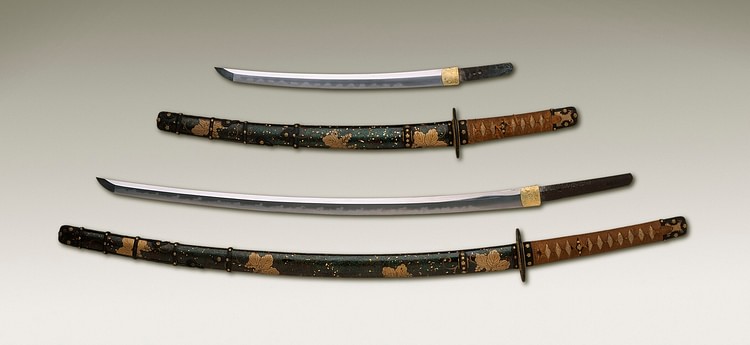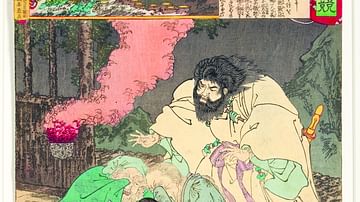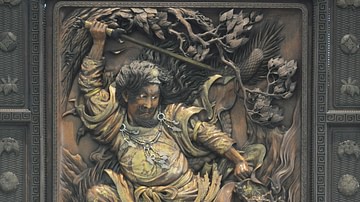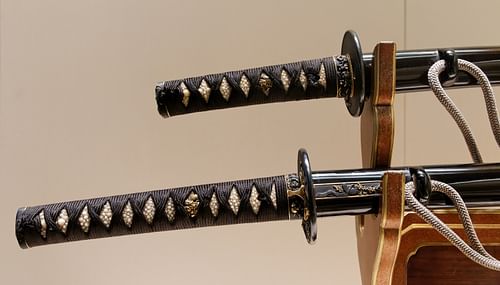
Swords used by Japanese samurai were renowned for the craftsmanship which produced strong yet flexible curved steel blades with a single, super-sharp cutting edge. Produced from the 8th century CE onwards and symbolic of the samurai's elevated status in Japanese society, many swords were both deadly weapons and family heirlooms. Fortunately, fine examples of Japanese medieval swords survive in museums worldwide today, and several are even listed as official National Treasures of Japan.
Swords in Japanese Mythology
Reverence for swords goes back a long way in Japanese culture. A sword is one of the three sacred Shinto relics that make up the Japanese imperial regalia. According to legend, Susanoo, the Shinto storm god, killed a giant serpent called Yamato-no-Orochi (aka Koshi) which was terrorizing the province of Izumo. From the dead creature's belly, Susanoo discovered the special sword, the Kusanagi or 'grass-cutter' (in other versions of the story he extracts it from the serpent's tail). This sword, he presented to his sister Amaterasu who later gave it to her grandson Ninigi who was the first ancestor of the Japanese imperial family. In this way, the sword became a part of the imperial regalia, today preserved in the temple of Atsuta near Nagoya.
Swords feature prominently in other tales of Japanese mythology, especially in such works as the Kojiki ('Record of Ancient Things'), compiled in 712 CE by the court scholar Ono Yasumaro. Within this work, the oldest text of any kind from Japan, great and magical swords go by such names as Heavenly-Point-Blade-Extended, Beard-Cutter and Great-Blade-Mower. Several special swords were considered kami or Shinto spirits in their own right. Not always considered a weapon of destruction, the Bodhisattva Kokuzo-Bosatsu of Japanese Buddhism, for example, is often depicted in Japanese art holding the sword of happiness in his right hand, a symbol of the bounty of heaven.
The Sword as the Ultimate Weapon
Despite the sword's long history in myth and legend, it was actually the bow that was considered the primary weapon on the Japanese battlefield for much of the country's history. This situation lasted until the Mongol invasions of the late 13th century CE which gave swords the opportunity to shine on a more frenetic battlefield than Japan had witnessed previously. The long and super-sharp Japanese swords proved far more effective than the Mongol short swords, and neither could the invaders' light armour withstand the fearsome slashing blade of the samurai sword. Swords had, in fact, been used in Japan since antiquity but were of the straight-blade type and used for thrusting. By the middle of the Heian Period (794-1185 CE), though, and the appearance of the samurai, it was the curved and viciously sharp sword they carried that saw Japanese swordsmanship reach its zenith.
Although samurai often did not have any particular training schools, there were specialised schools of swordsmanship. Cutting an object with a single blow was especially practised and swordmen used as a target such items as bamboo, piles of tatami matting or bundles of straw. One rather unfortunate association with swords is the samurai warriors' infamous practice of testing their blades were still sharp by beheading total strangers on the roadside, a nasty habit known a tsujigiri or 'cutting down at the crossroads.'
Swords became exclusively associated with the samurai after 1588 CE when Toyotomi Hideyoshi (1537-1598 CE) promoted a lasting peace by forbidding anyone but members of the warrior class from carrying weapons. This was a strategy attempted by his predecessors and it became known as 'sword hunts' (katanagari) when officials ensured that nobody outside the government's army possessed swords, bows, spears, or muskets.
The Art of Steel Manufacture
Samurai sword blades were made in specialist workshops using steel in a manufacturing process which dated back to the Nara Period (710-794 CE). The steel was worked by master craftsmen who carefully controlled the carbon content in various parts of the blade for maximum strength and flexibility, as here explained by the historian W. E. Deal:
…during the Nara period, these technologically advanced blades were made of densely forged steel laboriously hammered, folded and welded multiple times in order to create a steel fabric of superior flexibility and integrity. Due to this process, Japanese-style blades have a complex, multilayered structure similar to the grain of wood, with a more flexible, lower carbon-content steel encased in (or layered with) a harder, more brittle outer surface that is exceptionally durable. The difference in the carbon content of the steel and the positioning of the contrasting metals also results in the characteristic curve of Japanese swords. (159)
Swordsmiths were not only admired and given a high social status for their practical skills but they also enjoyed a certain religious mystique thanks to their frequent association with Buddhist sects and their management of three of the five fundamental elements in Japanese folklore: fire, water, and metal.
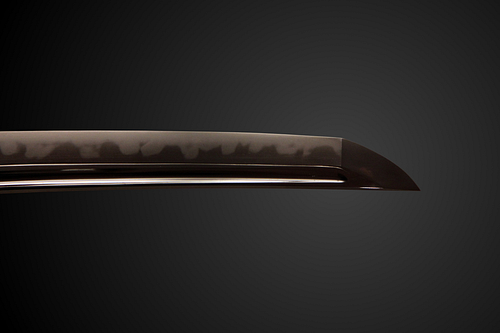
Once the smith was finished with the blade, it was passed on to a sharpener and polisher who used varying grades of stones with water to achieve a gleaming blade. Then, returned to the smith, the finished blade was given its engraving which included the maker's signature. Sometimes blades were tested for their cutting prowess, typically on a condemned criminal, and the results were occasionally noted on the blade itself. The day of manufacture and the name of the recipient might also be recorded on what became a busy writing space. There were even cases of less-gifted swordsmiths signing their swords as the work of more famous craftsmen in order to increase sales.
Another and much more sophisticated mark of identification of just who manufactured a sword was the hamon or the temper pattern of the cutting edge. This was achieved in the following process:
The hamon is a synergistic result of three events that contribute to the final hardening of the sword's cutting surface. First, clay is applied to the blade and allowed to dry. Then, the sword is repeatedly passed through a high-temperature charcoal fire for a specified amount of time, until it reaches the temperature desired by the smith. Finally, the blade is plunged into a tank of water, calibrated precisely to complement the amount of time spent in the fire at a certain temperature. The combination of these three factors determines the form of the hamon and is a closely guarded secret in each smith's workshop. (Deal, 159-160)
The production of swords received support right from the very top with such notable figures as emperor Go-Toba (r. 1184-1198 CE) enticing 12 master swordsmiths to his workshop at Heiankyo (Kyoto). Although these masters, collectively known as Ban-kaji, were in such demand they could only be persuaded to spend one month each year at the capital. The most esteemed swordsmiths often formed their own manufacturing schools, as was the case with Goto Yujo (d. 1512 CE) whose school lasted 400 years.
With all this care and attention combined with technical expertise in steelworking, it is fair to say that Japanese swords were amongst the finest and sharpest ever produced in the medieval world. Certainly, Japanese swords were in much demand in medieval China where they could be sold at a 500% profit throughout the medieval period.
Types of Swords
Samurai swords were slightly curved, and blades varied in length, but it became common for elite samurai to carry two swords - a long and a short one. This pair became known as the daisho ('great and small') from the 1580s CE and were usually made to match in terms of colour and decoration. The longer sword (katana) had a blade of around 60 cm (2 ft) and the shorter sword (wakizashi or tsurugi) had a blade of 30 cm. Both swords were worn with the cutting edge uppermost and the short sword was the one worn when the samurai was indoors. Before the katana sword came along there were two larger swords. The 'mallet-headed' sword, which had an especially heavy pommel to balance the great length of the blade, and the tachi, which had a blade of up to 90 cm (3 ft). A tachi sword was worn with the cutting edge facing down, hung suspended from the belt using cords while the other types were thrust through the belt.
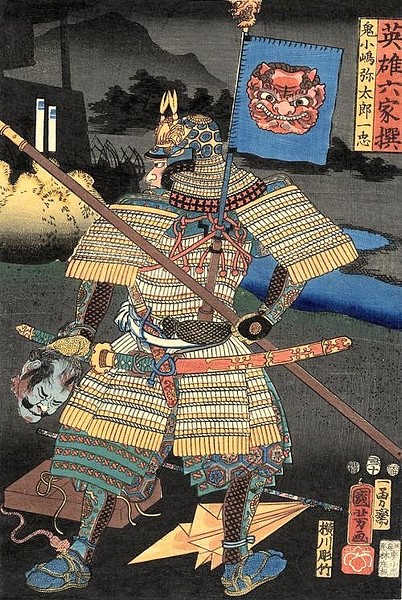
Sword handles (tsuka) were made of wood and covered in the tough skin of the giant ray (same) and then tightly bound in silk braid, typically of a dark blue colour. The blade was separated from the handle by a small circular hand guard (tsuba). The handle, often a work of art in its own right, might be protected by a metal sleeve (fuchi) which could be decorated, like the handle itself with landscape scenes and relief figures of such favourite subjects as lions and dragons. A samurai might also carry a short dagger (tanto) as a weapon of last resort (distinguishable from the short sword by its lack of a handguard). Both swords and daggers were kept in lacquered scabbards which could be highly decorative but were more often minimalist in design. Finely-worked swords took a long time to make, and they were often given as a gift of gratitude to samurai by their lord and then passed down as family heirlooms. Stands and racks to display fine swords in the home became yet another area for artists to express their skills in carving and metalwork.
Finally, the sword of a samurai was an essential part of the ritual suicide known as seppuku which many warriors were expected to commit if their lord were killed or they lost a battle. Cutting their abdomen with a knife stroke from left to right, an assistant was usually on hand with a special sword, known as a kaishakunin, to swiftly decapitate the samurai.
Decline in Use
With the introduction of European firearms to Japan in the mid-16th century CE, the sword began to go into decline. So much history and folklore were attached to Japanese swords, though, that their mystique far outlasted their practical use in battle. Swordsmanship remained an admired skill amongst Japan's elite; Tokugawa shoguns had their own personal instructors in order to hone the technique. Just as medieval samurai were eulogised in the literature of the pre-modern era, so, too, swords were held up as the ideal fighting weapon of the now-long-gone chivalrous warrior. Around 1643 CE, for example, the famous Gorin no sho ('Book of Five Rings') was published. Written by Miyamoto Musashi, a former master swordsman and developer of the two-sword technique known as nito-ryu, it examined swordsmanship and extolled the loyal service of samurai who existed only to serve their lord. After 1867 CE retired samurai were no longer permitted to carry swords. Fortunately for posterity, a great number of swords have outlasted their owners thanks to the reverence paid to these valuable works of craftsmanship. Today, museums worldwide contain many fine examples of samurai swords, especially the koto or 'old swords' which were made before 1600 CE; several of these masterpieces are listed as official National Treasures of Japan.
This content was made possible with generous support from the Great Britain Sasakawa Foundation.
